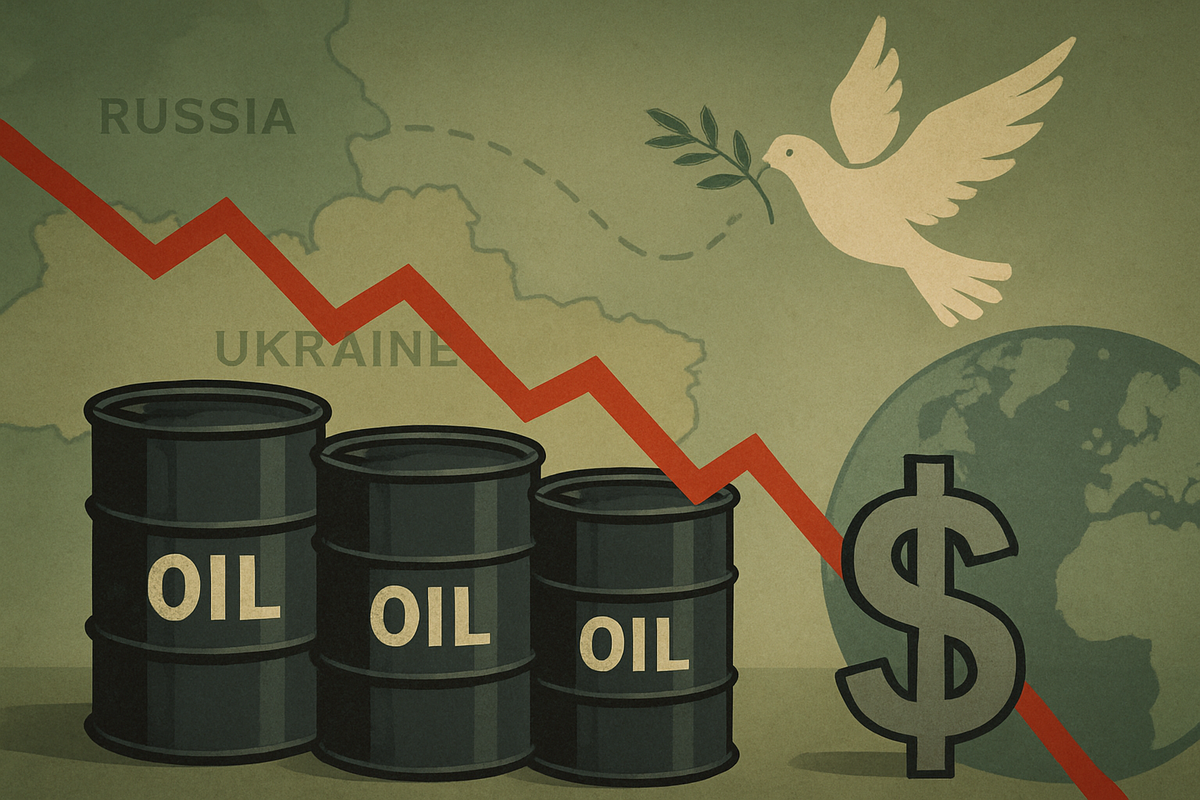
London, November 26, 2025 – Global oil futures prices have experienced a significant downturn in late November 2025, with both Brent and West Texas Intermediate (WTI) crude benchmarks falling to five-week lows. This sharp decline is primarily driven by escalating hopes for a peace deal between Russia and Ukraine, which the market anticipates could lead to an influx of Russian oil and exacerbate an already projected global oversupply. The financial world now keenly awaits Russia's definitive response to a U.S.-backed peace framework, a development that promises to reshape the energy landscape and dictate market volatility in the coming weeks.
The prevailing sentiment is that a successful peace agreement could lead to the easing of Western sanctions on Russian energy exports, thereby unleashing a substantial volume of crude onto a market already struggling with excess supply. This potential shift has prompted a bearish outlook among investors, overriding other factors, including recently imposed U.S. sanctions on Russian oil companies. The current market dynamics underscore the profound influence of geopolitical developments on commodity prices and highlight the delicate balance between supply, demand, and political stability.
Geopolitical Shifts Drive Oil Market Downturn
The current state of the oil market is a direct reflection of rapidly evolving geopolitical circumstances. As of November 26, 2025, WTI crude oil futures are trading around $58 per barrel, having seen a notable drop from recent highs. Brent crude futures are similarly hovering near $62.5 to $63 per barrel, also at five-week lows. This downward trend intensified on November 25 and 26, largely in response to optimistic signals emanating from the Russia-Ukraine peace talks.
The most critical development is the growing prospect of a peace agreement between Russia and Ukraine. Ukrainian President Volodymyr Zelenskiy has indicated a readiness to move forward with a U.S.-backed framework, suggesting that only a few points of disagreement remain. U.S. President Donald Trump has reportedly dispatched representatives to finalize the deal, with a refined 19-point proposal (from an initial 28) reportedly largely accepted by Ukraine. While Russia's public stance remains somewhat ambiguous, Moscow has referred to the revised plan as the "only substantive" one. This progress has led analysts to suggest that a finalized deal, by potentially dismantling Western sanctions on Russian energy exports, could push WTI prices further towards $55 per barrel.
Adding to the supply-side concerns, the OPEC+ alliance, following its November 2, 2025 meeting, decided to increase oil output by 137,000 barrels per day (bpd) for December 2025, continuing a trend of gradual increments. Although OPEC+ plans to pause these increases in January, February, and March 2026 due to seasonal demand patterns, the overarching strategy has been to steadily restore 2.2 million bpd of voluntary cuts. Concurrently, new U.S. sanctions targeting Russia's two largest oil companies, which came into effect around November 21-25, 2025, have led to a reduction in Russian oil purchases by refineries in India and China. However, the market impact of these sanctions has been largely overshadowed by the broader optimism surrounding the peace deal. Reflecting this bearish outlook, hedge funds have moved into net short positions on U.S. crude futures, and trend-following commodity trading advisers went fully short on both WTI and Brent contracts on November 21, 2025.
Companies Poised to Win or Lose in a Shifting Landscape
The significant drop in oil prices, driven by the prospect of increased supply and geopolitical stability, will inevitably create winners and losers across various sectors of the global economy.
Companies that stand to benefit most from lower oil prices are typically those with high fuel consumption costs. Airlines, for instance, such as Delta Air Lines (NYSE: DAL), Southwest Airlines (NYSE: LUV), and United Airlines Holdings (NASDAQ: UAL), will see a direct reduction in operational expenses, potentially boosting their profitability and allowing for more competitive pricing. Similarly, shipping and logistics companies, whose fuel bills constitute a substantial portion of their operating costs, could experience significant relief. Consumers, too, will be indirect beneficiaries, as lower fuel prices translate into reduced transportation costs and potentially more disposable income, stimulating broader economic activity.
Conversely, the primary losers in this scenario are the oil and gas exploration and production (E&P) companies. Major integrated oil companies like ExxonMobil (NYSE: XOM), Chevron (NYSE: CVX), Shell plc (LSE: SHEL), and BP p.l.c. (LSE: BP) will face reduced revenues and profitability as the value of their primary commodity decreases. Smaller independent producers, often with higher break-even costs, could be particularly vulnerable to sustained low prices, potentially leading to curtailed investment in new projects or even solvency issues. Oilfield services companies, such as Schlumberger (NYSE: SLB) and Halliburton (NYSE: HAL), which provide drilling, completion, and other support services to producers, will likely see a slowdown in demand for their services as E&P companies scale back operations in response to lower prices.
Broader Implications and Historical Context
This event fits into a broader trend of market sensitivity to geopolitical events, particularly concerning major energy producers like Russia. The potential re-entry of significant Russian crude volumes into the global market would exacerbate an already anticipated global oversupply. Forecasts suggest surpluses of 2.3-3.0 million bpd in 2025 and 4.0 million bpd in 2026, driven by increased OPEC+ output and robust production from non-OPEC+ nations, including the U.S., Brazil, and Guyana. This oversupply could exert sustained downward pressure on prices, challenging the profitability of many producers.
The ripple effects extend beyond the energy sector. Lower oil prices generally act as a stimulus for global economic growth by reducing input costs for industries and increasing consumer purchasing power. This could provide a tailwind for economies grappling with inflation or seeking to avoid recession. However, it also poses challenges for energy-dependent economies that rely heavily on oil exports for revenue. Regulatory and policy implications are significant, as a peace deal could necessitate the dismantling of Western sanctions on Russian energy, requiring complex diplomatic and legislative processes. Historically, periods of geopolitical de-escalation, such as the end of the Gulf War or certain phases of the Iran nuclear deal, have often led to increased supply expectations and corresponding drops in oil prices, offering a precedent for the current market reaction.
Navigating the Path Ahead
The immediate future of oil prices hinges critically on Russia's definitive response to the peace framework. In the short term, a clear acceptance of the deal could trigger further significant price declines, potentially pushing WTI closer to the $55 per barrel mark or even lower. Conversely, any faltering of the peace talks, or a rejection from Moscow, could lead to a swift rebound in prices as geopolitical risk premiums reassert themselves. The upcoming OPEC+ meeting on November 30, 2025, will also be crucial, as the alliance is expected to maintain current production levels and focus on setting 2027 baselines. Their decisions will significantly influence the global supply picture.
In the long term, the market will need to adapt to a potentially new equilibrium of supply and demand. If Russian oil flows unimpeded, the challenge of managing global oversupply will intensify, potentially accelerating the energy transition as traditional fossil fuel investments become less attractive. Strategic pivots for oil companies might include increased focus on cost efficiency, diversification into renewable energy sources, or consolidation within the industry. Market opportunities could emerge in sectors that benefit from lower energy costs, while challenges will persist for upstream producers. Potential scenarios range from a sustained period of lower oil prices, fostering global economic growth, to renewed volatility if geopolitical tensions flare up again.
A Market in Flux: Key Takeaways for Investors
The current market environment is characterized by significant flux, with geopolitical developments acting as the primary catalyst for recent price movements. The prevailing sentiment is that hopes for a Russia-Ukraine peace deal are driving oil futures lower, creating a potential scenario of global oversupply. This has led to a bearish positioning among sophisticated investors, with hedge funds and commodity trading advisers moving into net short positions.
Moving forward, the market will remain highly sensitive to news regarding the peace negotiations and Russia's official stance. Investors should closely monitor diplomatic efforts, statements from key stakeholders, and the outcomes of the upcoming OPEC+ meeting. While lower oil prices can provide a boost to certain sectors and the broader economy, they present a considerable challenge for oil and gas producers. The long-term implications could include a re-evaluation of energy investment strategies and an accelerated shift towards alternative energy sources.
This content is intended for informational purposes only and is not financial advice







